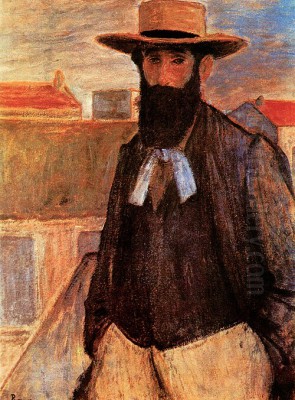
Aristide Maillol stands as a pivotal figure in the transition from 19th-century sculpture to the diverse forms of modernism. A French artist born in 1861 in the Mediterranean town of Banyuls-sur-Mer and passing away in 1944 near his birthplace, Maillol dedicated his mature career primarily to the exploration of the female form. Working as a sculptor, painter, and printmaker, he forged a unique path, drawing inspiration from classical antiquity while simplifying forms in a way that resonated with emerging modern aesthetics. His work represents a calm, structured counterpoint to the emotional intensity of his predecessor, Auguste Rodin, and laid groundwork for subsequent generations of sculptors. Maillol's art is characterized by its harmony, balance, and a profound sense of timeless serenity.
Early Life and Artistic Awakening
Aristide Joseph Bonaventure Maillol was born into a family with roots in the Roussillon region of Catalonia, France. His early inclinations were towards painting. Driven by this passion, he moved to Paris in 1881, seeking formal artistic training. After initial difficulties, he was admitted to the prestigious École des Beaux-Arts in 1885. There, he studied under prominent academic painters like Jean-Léon Gérôme and Alexandre Cabanel. However, Maillol found the rigid academicism of the official Salon system stifling.
He sought inspiration elsewhere, looking towards artists who challenged conventional approaches. He admired the murals of Pierre Puvis de Chavannes for their simplified forms and serene compositions. A more profound influence came from the Post-Impressionist painter Paul Gauguin, whose bold use of color, flattened perspectives, and interest in non-Western or "primitive" art forms resonated deeply with Maillol's desire for a more direct and decorative mode of expression. This period marked the beginning of Maillol's departure from academic painting towards a more personal artistic vision.
The Nabis Connection and Decorative Arts
During the early 1890s, Maillol became associated with Les Nabis, a group of young artists inspired by Gauguin. This group, including Pierre Bonnard, Édouard Vuillard, and Maurice Denis, sought to break down the barriers between fine and decorative arts. They emphasized flat patterns, subjective color, and symbolic content. Encouraged by Gauguin himself, Maillol turned his attention towards the decorative arts, particularly tapestry design.
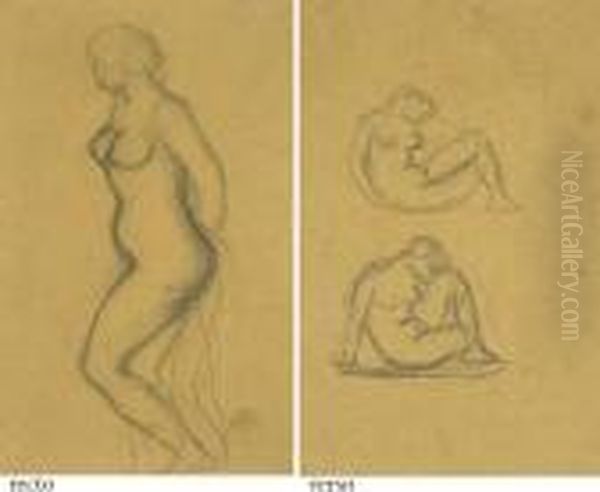
Around 1893, he established a small tapestry workshop in Banyuls, employing local women to execute his designs. His tapestries, like his paintings from this period, reflected the Nabis aesthetic with their simplified forms, decorative motifs, and harmonious color schemes. He also formed a close friendship with the Hungarian artist József Rippl-Rónai, another associate of the Nabis, with whom he shared ideas about art and craft. This phase was crucial for Maillol, as it honed his sense of design, composition, and the simplification of form – skills that would prove fundamental to his later sculptural work.
The Turn to Sculpture
A significant shift occurred in Maillol's career around the turn of the century, near the age of 40. Deteriorating eyesight, strained by the close work required for tapestry weaving, forced him to abandon that medium. Encouraged perhaps by his earlier experiments with small clay figures and Gauguin's own work in ceramics and wood carving, Maillol began to focus seriously on sculpture. This was not an entirely abrupt change, as his Nabis-influenced work already showed a strong sense of volume and simplified form.
He started with small terracotta figures, often depicting the robust local women of Banyuls. These early sculptures already displayed characteristics that would define his mature style: a focus on stable, self-contained volumes, smooth surfaces, and a sense of quiet monumentality, even on a small scale. This transition marked the beginning of Maillol's most significant contribution to art history, establishing him as a key figure in the revitalization of sculpture in the early 20th century.
Defining a Sculptural Style: Harmony and Form
Maillol's mature sculptural style represented a distinct break from the dominant influence of Auguste Rodin. Where Rodin's work emphasized movement, psychological drama, and textured surfaces that captured the play of light, Maillol sought stillness, structural clarity, and serene harmony. His primary subject became the female nude, but treated not as a specific individual or a vehicle for overt emotion, but as an embodiment of universal, timeless forms.
His figures are typically characterized by their solid, rounded volumes, smooth surfaces, and balanced, often architectonic poses. He simplified anatomy, focusing on the essential masses and rhythms of the body. There is a sense of calm, introspection, and self-containment in his figures. Maillol drew heavily on the spirit of Archaic and Classical Greek sculpture, admiring its clarity, order, and idealized representation of the human form. He sought to create works that possessed a similar sense of permanence and quiet dignity, stripping away the anecdotal or overly decorative elements common in 19th-century sculpture.
Classical Ideals Reimagined for a Modern Age
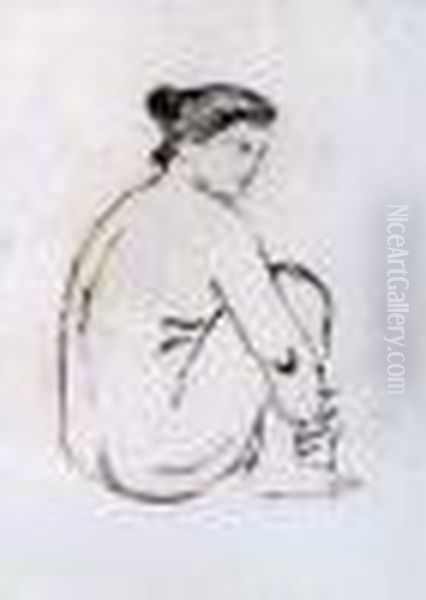
Maillol's engagement with classicism was not merely imitation; it was a reinterpretation through a modern sensibility. He absorbed the lessons of Greek sculpture – its balance, its understanding of volume, its idealization – but filtered them through his own focus on simplified, essential forms. This connection led some critics, like Maurice Denis, to call him the "Cézanne of sculpture." Just as Paul Cézanne sought to reveal the underlying geometric structure in nature through painting, Maillol explored the fundamental volumes and architectural possibilities of the human figure in three dimensions.
His approach emphasized structure and mass over narrative or fleeting effects. The figures often appear static, grounded, and self-possessed, conveying a sense of enduring presence. He favored materials like bronze, terracotta, and stone, which lent themselves to the creation of clear, defined forms and smooth surfaces. This modern classicism offered an alternative to both academic realism and the expressive turbulence of Rodin, influencing a generation of sculptors seeking order and formal purity.
Masterworks of Serenity and Strength
Maillol's oeuvre includes several iconic works that exemplify his style. One of his earliest major sculptures, conceived around 1902 and finalized by 1905, is La Méditerranée (The Mediterranean). This seated female figure, resting her head on her arm in quiet contemplation, became a landmark of early modern sculpture. Its simplified volumes, stable pyramidal composition, and profound sense of stillness were revolutionary, signaling a move away from Rodin's dynamism. It was exhibited to great acclaim at the Salon d'Automne in 1905.
Another key work is La Nuit (Night, c. 1902-1909), a seated figure huddled with her head tucked between her knees, conveying introspection and withdrawal. L'Action enchaînée (Action in Chains, 1905-1908), created as a monument to the socialist revolutionary Louis Auguste Blanqui, depicts a powerful female figure straining against unseen bonds. Despite the title, the figure retains a sense of contained energy and massive form rather than overt struggle.
Later works continued to explore variations on the female form, often in standing or reclining poses. Pomona (c. 1910) and Flora (c. 1910) personify classical goddesses of fruit and flowers with robust, earthy forms. Île-de-France (1925) presents a more slender, athletic figure stepping forward. His late works, such as La Montagne (The Mountain, 1937) and the four allegorical figures representing rivers, including La Rivière (The River, 1938-1943), often feature reclining figures that interact dynamically with their base, suggesting landscapes or natural forces embodied in human form. He also created significant war memorials, notably the Monument aux Morts in his native Port-Vendres.
Enduring Engagement with Painting and Printmaking
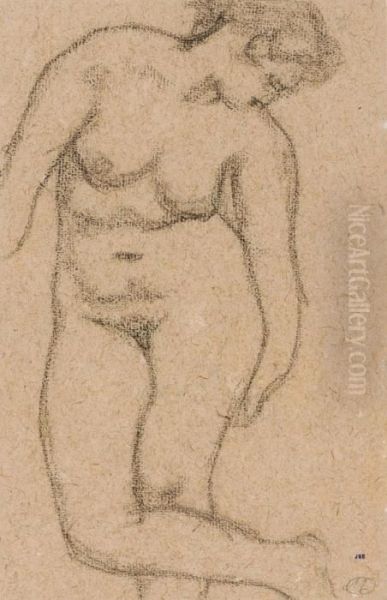
Although sculpture became his primary focus, Maillol never entirely abandoned two-dimensional work. He continued to paint throughout his life, often depicting landscapes of Banyuls or studies of the female nude. His paintings, such as Profil de femme (Profile of a Woman) or the earlier La Jeune Fille (The Young Girl, 1896), often retain echoes of the Nabis' flattened perspectives and decorative qualities, combined with his sculptor's sense of volume.
He was also a master printmaker, particularly skilled in woodcut. He produced illustrations for several classic texts, bringing his distinct style to the printed page. Notable projects include woodcuts for Virgil's Georgics (undertaken late in life, 1937-1944), Longus's Daphnis and Chloe, and Pierre de Ronsard's Livret de Folastries. These illustrations demonstrate his ability to translate his sculptural sensibility – clear lines, balanced compositions, idealized forms – into graphic media, creating harmonious integrations of text and image.
Dina Vierny: Muse, Model, and Legacy Keeper
No account of Maillol's life and work is complete without mentioning Dina Vierny (1919-2009). Introduced to the aging sculptor in 1934 when she was just fifteen, she became his final and most important model, muse, and close companion during the last decade of his life. Vierny's youthful, sturdy physique inspired many of Maillol's late masterpieces, including La Montagne and La Rivière.
Beyond her role as a model, Vierny was an intelligent and resourceful individual. During World War II, she actively participated in the French Resistance, helping refugees escape across the Pyrenees near Banyuls, sometimes with Maillol's knowledge or assistance. After Maillol's death, Dina Vierny became the executor of his estate and a tireless champion of his work. She was instrumental in the donation of his major sculptures for permanent display in the Tuileries Garden in Paris in 1964 and later founded the Musée Maillol in Paris (opened 1995), dedicated to his art and that of his contemporaries.
Exhibitions, Recognition, and Support
Maillol achieved recognition relatively early in his sculptural career. His work was championed by the influential art dealer Ambroise Vollard, who gave him his first solo sculpture exhibition in Paris in 1902. His appearance at the 1905 Salon d'Automne solidified his reputation as a major new force in sculpture. He exhibited internationally, and important patrons and collectors, including Count Harry Kessler of Germany and Ivan Morozov of Russia, acquired his work.
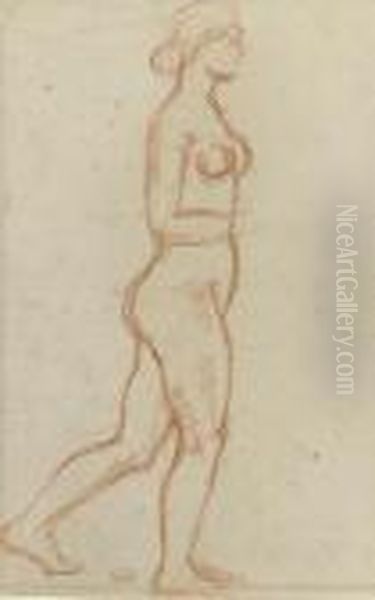
The art dealer Alfred Flechtheim organized a significant exhibition of Maillol's sculptures and paintings in Berlin in 1928. Major retrospectives and thematic exhibitions have continued long after his death, including "Hommage à Maillol" in Paris (1957), large-scale reviews at the Musée d'Orsay in Paris (2021-2022) and the Musée des Beaux-Arts in Lyon (2022), and focused shows at the Musée Maillol, such as the dialogue with photographer Elliott Erwitt (2023). The prominent placement of his monumental bronzes in the Tuileries Garden ensures his continued visibility and public appreciation.
Critical Reception and Enduring Influence
Art critics quickly recognized Maillol's importance. He was hailed for returning a sense of order, harmony, and timelessness to sculpture after the emotionalism of Rodin. His synthesis of classical principles with a modern simplification of form was widely admired. Comparisons to masters of the past, like the sculptors of Archaic Greece or even Renaissance artists, were common, alongside acknowledgments of his modernity, such as the "Cézanne of sculpture" analogy. His focus on the serene, idealized female form became his signature.
However, his work was not without its detractors. Some later critics, particularly those championing more radical forms of abstraction or expressionism, found his adherence to the figure and classical balance conservative. His political position during the German Occupation of France in World War II also drew controversy, although the extent and nature of any collaboration remain debated.
Despite these points, Maillol's influence on subsequent 20th-century sculpture was profound. His emphasis on simplified volumes, truth to materials, and structural integrity resonated with many artists moving towards abstraction. Sculptors like Constantin Brâncuși, Jean Arp, and Henry Moore acknowledged his importance. Moore, in particular, admired Maillol's weighty, grounded forms and his connection to classical and archaic traditions. Figurative sculptors like Gaston Lachaise and Alberto Giacometti (in his earlier, more solid figures) also show traces of his influence. Maillol effectively provided a bridge between 19th-century traditions and the burgeoning possibilities of modern sculpture.
Later Life and Lasting Legacy
Maillol spent much of his later life working between his studio in Marly-le-Roi near Paris and his native Banyuls-sur-Mer. During World War I, he was briefly detained on suspicion of espionage due to his Catalan background and connections abroad, but was soon released. He continued to receive important commissions and refine his sculptural vision throughout the interwar period and into the early years of World War II.
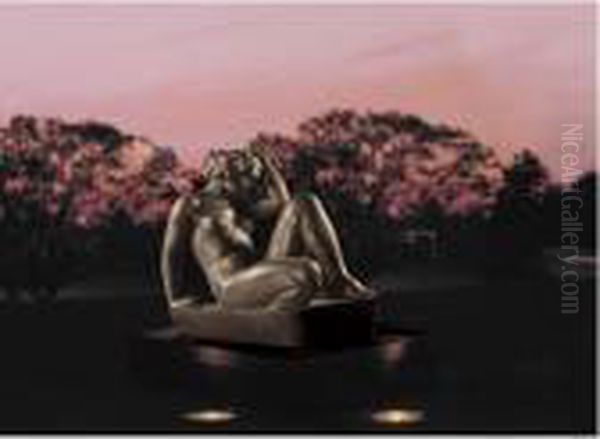
In September 1944, shortly after the liberation of France, Aristide Maillol was involved in a car accident while traveling near Banyuls. He died from his injuries a few days later, at the age of 82. He left behind a significant body of work and a legacy preserved not only in museums and public spaces worldwide – from MoMA in New York to the Hirshhorn Museum in Washington D.C., and major European collections – but also through the dedicated efforts of Dina Vierny and the foundation she established.
Conclusion: A Monument to Harmony
Aristide Maillol occupies a crucial and unique position in the history of modern art. He navigated the complex currents of the early 20th century, drawing inspiration from the deep past while forging a distinctly modern sculptural language. Rejecting both sterile academicism and excessive emotionalism, he focused on the enduring beauty and structural possibilities of the human form, particularly the female nude. His sculptures are monuments to harmony, balance, and serene contemplation. By simplifying forms and emphasizing volume and structure, he created works of quiet power and timeless appeal, paving the way for new directions in sculpture while remaining true to a vision rooted in classical ideals. His legacy endures in the tranquil presence of his figures and his profound influence on the course of modern art.